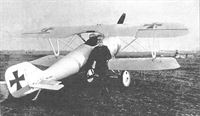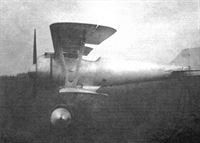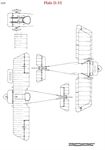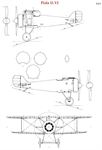
| Самолеты (сортировка по:) | |||||
| Страна | Конструктор | Название | Год | Фото | Текст |
Pfalz D.VI

|
Страна: Германия Год: 1917
Fighter |
| Pfalz - D.IV/D.V - 1917 - Германия | <– | –> | Pfalz - D.VII/D.VIII - 1917 - Германия |
 |
J.Herris - Pfalz Aircraft of WWI /Centennial Perspective/ (5) |
| Pfalz test pilot Otto August with an unarmed Pfalz D.VI.The small scoop on the fuselage was the carburetor air intake for the 110 hp Oberursel Ur.II engine. The elegant Pfalz D.VI, powered by a 110 hp Oberursel Ur.II rotary, did not go into production despite its good maneuverability and flying qualities. The reason for this is not known but possibly was connected with the general shortage of lubricants for rotary engines in Germany. It appeared in January 1917, when the Albatros reigned supreme, and that may have been the real reason it was not built. By the time it was considered for production a year later, it was now too slow to be competitive. |
 |
J.Herris - Pfalz Aircraft of WWI /Centennial Perspective/ (5) |
| Pfalz D.VI prototype |
 |
J.Herris - Pfalz Aircraft of WWI /Centennial Perspective/ (5) |
| Leutnant Wilhelm Frankl and the prototype Pfalz D.VI photographed during his visit to the Pfalz factory in February-March 1917. Frankl, son of a Jewish salesman, scored 20 confirmed victories and was awarded the Pour le Merite on 12 July 1916. He went to Jasta 4 on 1 September 1916 and later became Staffelfuhrer. He was killed in action on 8 April 1917. |
 |
J.Herris - Pfalz Aircraft of WWI /Centennial Perspective/ (5) |
 |
J.Herris - Pfalz Aircraft of WWI /Centennial Perspective/ (5) |
| Lt. Frankl emphasizes the small size of the Pfalz D.VI. |
 |
J.Herris - Pfalz Aircraft of WWI /Centennial Perspective/ (5) |
| The Pfalz D.VI armed with twin Spandau LMG 08/15 machine guns for the type-test at Adlershof in August-September 1917. The beautifully streamlined fuselage made possible by the Wickelrumpf technique is evident. |
 |
J.Herris - Pfalz Aircraft of WWI /Centennial Perspective/ (5) |
| The King of Bavaria visits the Pfalz factory on 7 May 1917. This dark-painted Pfalz D.VI without spinner was one of the aircraft demonstrated in flight for the King. This indicates more than one D.VI was built. |
 |
W.Green, G.Swanborough - The Complete Book of Fighters |
| The D VI which was flown early in 1917. |
 |
J.Herris - Pfalz Aircraft of WWI /Centennial Perspective/ (5) |
| Pfalz D.VI |
 |
J.Herris - Pfalz Aircraft of WWI /Centennial Perspective/ (5) |
| Pfalz D.VI |
 |
J.Herris - Pfalz Aircraft of WWI /Centennial Perspective/ (5) |
| Pfalz D.VI |